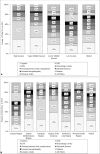Global, regional and national burden of emergency medical diseases using specific emergency disease indicators: analysis of the 2015 Global Burden of Disease Study
- PMID: 30997158
- PMCID: PMC6441258
- DOI: 10.1136/bmjgh-2018-000733
Global, regional and national burden of emergency medical diseases using specific emergency disease indicators: analysis of the 2015 Global Burden of Disease Study
Abstract
Objective: There are currently no metrics for measuring population-level burden of emergency medical diseases (EMDs). This study presents an analysis of the burden of EMDs using two metrics: the emergency disease mortality rate (EDMR) and the emergency disease burden (EDB) per 1000 population at the national, regional and global levels.
Methods: We used the 1990 and 2015 Global Burden of Disease Study for morbidity and mortality data on 249 medical conditions in 195 countries. Thirty-one diseases were classified as 'emergency medical diseases' based on earlier published work. We developed two indicators, one focused on mortality (EDMR) and the other on burden (EDB). We compared the EDMR and EDB across countries, regions and income groups and compared these metrics from 1990 to 2015.
Results: In 2015, globally, there were 28.3 million deaths due to EMDs. EMDs contributed to 50.7% of mortality and 41.5% of all burden of diseases. The EDB in low-income countries is 4.4 times that of high-income countries. The EDB in the African region is 273 disability-adjusted life years (DALYs) per 1000 compared with 100 DALYs per 1000 in the European region. There has been a 6% increase in overall mortality due to EMDs from 1990 to 2015. Globally, injuries (22%), ischaemic heart disease (17%), lower respiratory infections (11%) and haemorrhagic strokes (7%) made up about 60% of EMDs in 2015.
Conclusion: Globally, EMDs contributed to more than half of all years of life lost. There is a significant disparity between the EDMR and EDB between regions and socioeconomic groups at the global level.
Keywords: burden of diseases; emergency care; emergency medicine; indicators; international health.
Conflict of interest statement
Competing interests: None declared.
Figures




References
LinkOut - more resources
Full Text Sources
